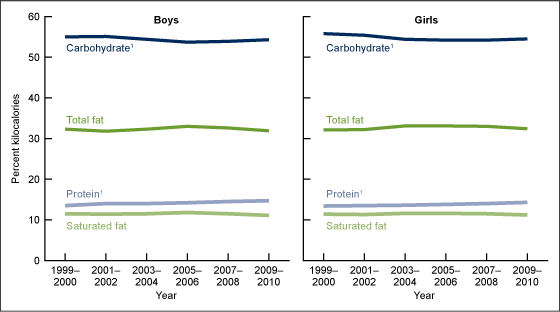With approximately one-third of US kids overweight or obese, a new government report finding that children of most ages are eating even slightly fewer calories overall is positive news, even if the dip is relatively slight.
The Centers for Disease Control & Prevention (CDC) report found that overall caloric intake for most girls and boys ages 2 through 19 decreased over the 12-year period between two national health surveys. One survey was conducted over 1999–2000 then it was given again in 2009–2010.
Girls overall ate approximately 75 fewer calories; boys ate 150 fewer.
The report highlights the importance of healthy eating habits for kids. Obese children are more likely to become obese adults. And excess body fat increases the risk of seven types of cancers, including post-menopausal breast, colorectal, and pancreatic.
When the researchers looked at how many calories were coming from proteins, carbohydrates, and fats they found some modest trends appear among both girls and boys for all races and ethnicities combined. The percentage of calories from protein increased about 1 percent overall for ages 2 through 19 (from 13.5 percent to 14.7 percent for boys; 13.4 percent to 14.3 percent for girls). The percentage of calories children and teens were taking in from carbohydrates dropped slightly (from 55 percent to 54.3 percent for boys; 55.8% to 54.5% for girls).
There were no differences in the percentage of calories from total fat or saturated fat. (The only trend in fat intake was a decrease in saturated fat consumption among Mexican-American boys and girls.)
 On average, boys and girls take in about one-third of their calories from total fat. The report found that the percentage of calories from saturated fat remains above the government health recommendation of 10 percent or lower. In 2009–2010, on average, U.S. children and adolescents consumed between 11 percent and 12 percent of their calories from saturated fat. Fat, by itself, is not linked to increased cancer risk. But it is a concentrated form of calories.
On average, boys and girls take in about one-third of their calories from total fat. The report found that the percentage of calories from saturated fat remains above the government health recommendation of 10 percent or lower. In 2009–2010, on average, U.S. children and adolescents consumed between 11 percent and 12 percent of their calories from saturated fat. Fat, by itself, is not linked to increased cancer risk. But it is a concentrated form of calories.
But at what ages the youths are consuming fewer calories over the 12-year period appears to be opposite for each gender. The report found that boys are consuming fewer calories when younger – ages 2 though 11 – there was no stable trend for calorie intake for adolescents. For girls, it was the adolescents – the 12 to 19 year olds – who appear to be consuming fewer calories over the time period studied. There was no stable trend in calorie consumption for younger girls.
Last month, AICR started a new campaign in partnership with SuperKids Nutrition with the goal to help families adopt healthy lifestyle habits in order to prevent cancer and other chronic diseases in the future. Visit Healthy Kids Today, Prevent Cancer Tomorrow for more information and activities.





